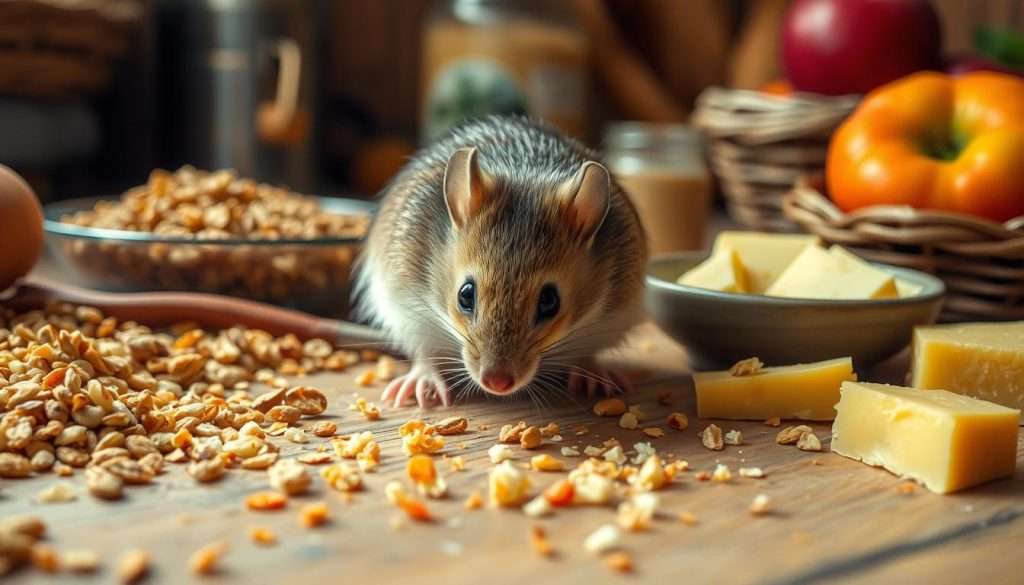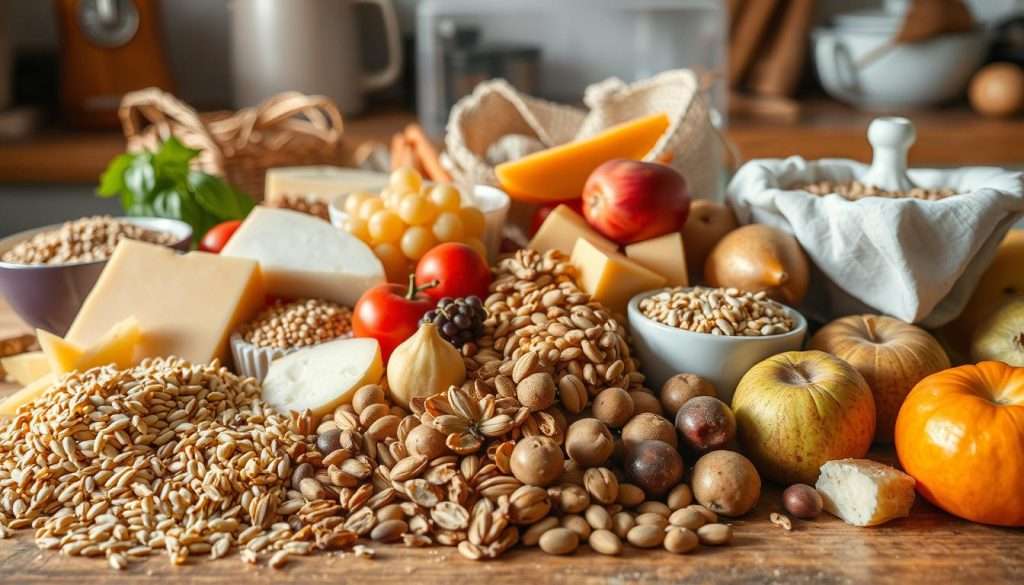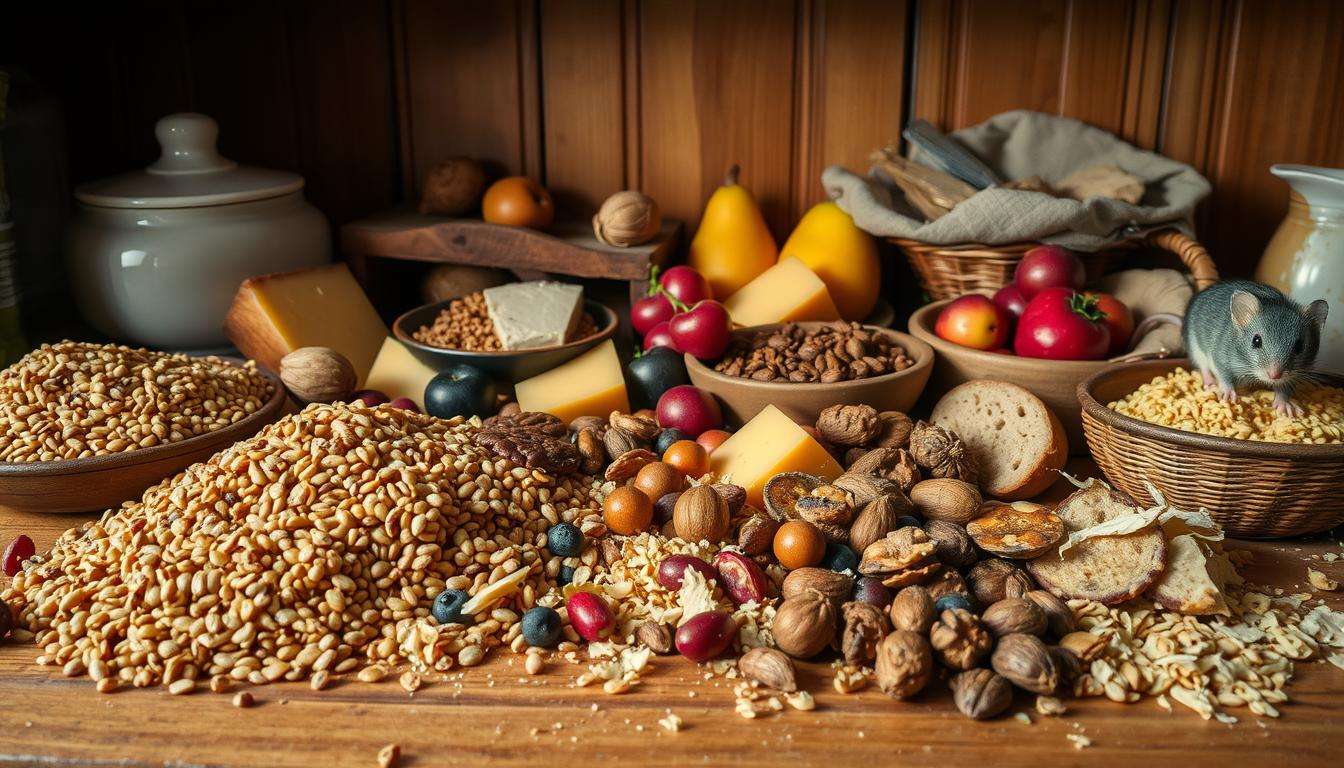Knowing what house mice eat is key for keeping your home pest-free. These mice are always on the lookout for food. They love grains, fruits, and seeds, which can harm your garden and crops.
But, they don’t like cheese as much as people think. Chocolate is a better choice for catching them. These mice can survive on little food, often finding it in our homes.
When food is scarce, they might even eat each other. They also chew on materials to build their nests. This can damage your home’s wiring and insulation.
Key Takeaways
- House mice eat a wide range of foods, including grains, seeds, and fruits.
- Carbohydrate-rich offerings are more appealing than traditional mouse bait like cheese.
- Mice can live on minimal resources and often forage in human habitats.
- Their nesting habits can lead to damage in both insulation and wiring.
- Understanding their diet is essential for effective pest prevention strategies.
The Omnivorous Nature of House Mice
House mice are very adaptable in their house mouse feeding habits. They eat a wide variety of foods. Knowing this helps us fight off these pests better.
Understanding House Mice Diet
House mice eat a lot, up to 15 to 20 times a day. They like grains, fruits, and even treats like chocolate and bacon. They need very little food to survive, just a few crumbs a day.
They often go for stored foods, especially grains like oats and wheat. These are in easy-to-reach places.
Common Preferences in Food Selection
House mice have certain foods they prefer. Some of their favorites are:
- Cereal grains (e.g., oats, wheat)
- Dried fruits
- High-fat items (e.g., cheese, bacon)
- Sweet foods (e.g., chocolate, sugary snacks)
- Seeds and nuts
This varied diet helps them survive. It also shows how they like to eat whatever they can find. Keeping food stored properly is key to keeping them away. For more info on mouse diets, see what house mice eat.

| Food Type | Common Preferences | Impact on Infestation Risk |
|---|---|---|
| Cereal Grains | High | Attracts mice due to easy access |
| Dried Fruits | Moderate | Can lure mice if left out |
| High-Fat Foods | Very High | Strong attractant; encourages frequent visits |
| Sweets | High | Highly appealing; increases risk of entry |
| Seeds/Nuts | Low to Moderate | Less attractive if stored properly |
What Do House Mice Eat: A Closer Look at Their Diet
Knowing what house mice eat is key to keeping them out of your home. Their varied house mice diet shows how adaptable they are. We’ll look at their favorite foods and what they naturally eat.
Top Food Choices for House Mice
House mice have certain foods they like more than others. Here are some of their favorites:
- Seeds and grains: These are big parts of their diet.
- Fruits and vegetables: They love apples, berries, and carrots.
- Nuts: Almonds and peanuts are also on their list.
- Human food: They’ll eat leftovers like bread, pasta, and cereal.
- Insects: Beetles and cockroaches are occasional snacks.
- Invertebrates: Snails and earthworms give them protein.
Natural Diet of House Mice in the Wild
House mice also eat certain foods in the wild. Their natural diet of house mice includes:
- Grasses and seeds: These are their main food sources.
- Fruits: They eat berries and fruits when they can.
- Insects and small invertebrates: These give them protein.
Harvested garden produce can attract house mice to homes. Knowing their house mice food preferences helps keep food safe. This makes it harder for them to get into our homes.

Impact of Food Availability on House Mouse Behavior
Food availability greatly affects house mice behavior. Knowing this helps homeowners stop infestations. Mice look for food, especially in cities where it’s easy to find.
Foraging Behavior and Habitats
House mice explore a lot when food is scarce. They become bolder and more visible. This can mean a mouse problem is starting.
They like to forage in:
- Kitchen floors
- Garbage cans
- Open pantries
These spots have plenty of food, making mice come out to eat. They hide in dark places to feel safe while they eat. Seeing droppings or hearing strange noises means they’re around.
Food Sources in Urban Environments
Urban areas have lots of food for mice. Places with trash, unsealed pantries, and restaurant waste are perfect for them. They go after:
- Restaurant waste
- Residential garbage
- Pet food left out
Being close to nature and having less food outside makes mice come inside. Changes in pet behavior or finding mouse nests are warning signs.
How Food Can Attract House Mice to Your Home
Knowing house mice food preferences helps keep them away. Food draws mice to our homes. Good storage is key to avoid them.
Storage Practices That Prevent Infestation
To prevent mice, keep food tight. Use containers made for food. Store pet food, grains, and snacks in these.
Mice can chew through weak packaging. So, use strong containers.
- Ensure leftover dinner scraps are cleaned up immediately.
- Store sweet fruits and berries in the fridge.
- Keep nuts and seeds sealed tightly to minimize attraction.
Cleanliness is also important. Throw away junk often. Keep surfaces clean of crumbs.
Common Household Items Mice Target
House mice like common household items mice target. They eat not just human food but other things too. Some things they like are:
| Item | Reason for Attraction |
|---|---|
| Pet food | Easily accessible high-protein source |
| Grains | Supports their natural scavenging behavior |
| Sweets | High sugar content attracts them |
| Paper products | Used for nesting materials due to softness |
| Leftover food in the trash | Offers an easy meal without much effort |
Mice can eat a lot, trying up to twenty foods in one night. Cutting down on their food helps keep them away. By being proactive, we can stop mice from taking over our homes.
Find out more about mouse food here.
Conclusion
Knowing what house mice eat is key to keeping our homes pest-free. These mice eat a wide range of foods, from grains to leftovers. This shows how important it is to understand their eating habits.
They can get into even the smallest openings. So, we must keep our food safe and away from them. This helps a lot in keeping them away.
Keeping our storage areas clean and tidy is also important. Mice eat a lot and often, so we need to watch our food closely. Cleaning up after meals helps a lot in keeping mice away.
Learning about house mice helps us protect our homes. Knowing their habits and what they like to eat helps us stop problems early. Let’s all work together to keep our homes clean and free from mice!
